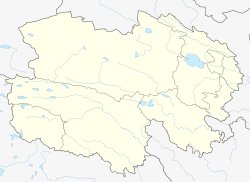
Back Minhe Huizu Tuzu Zizhixian CEB Minhe (Haidong) German Minhe Spanish Xian autonome hui et tu de Minhe French Contea autonoma hui e tu di Minhe Italian 民和回族トゥ族自治県 Japanese 민허 후이족 투족 자치현 Korean Minhe NB Minhe Polish Миньхэ-Хуэй-Туский автономный уезд Russian
Minhe County
民和县 | |||||||||||
|---|---|---|---|---|---|---|---|---|---|---|---|
| 民和回族土族自治县 • مٍهْ خُوِذُو تُوذُو ذِجِشِیًا • Miinhoo Hui szarbaten Mongghul szarbaten njeenaa daglagu xan • Kamalog Minhe Hui and Tu Autonomous County | |||||||||||
 | |||||||||||
| Coordinates (Minhe County government): 36°19′12″N 102°49′51″E / 36.3200°N 102.8308°E | |||||||||||
| Country | China | ||||||||||
| Province | Qinghai | ||||||||||
| Prefecture-level city | Haidong | ||||||||||
| County seat | Chuankou | ||||||||||
| Area | |||||||||||
| • Autonomous county | 1,891 km2 (730 sq mi) | ||||||||||
| Population (2020)[1] | |||||||||||
| • Autonomous county | 326,964 | ||||||||||
| • Density | 170/km2 (450/sq mi) | ||||||||||
| • Urban | 117,200 | ||||||||||
| • Rural | 320,900 | ||||||||||
| Time zone | UTC+8 (China Standard) | ||||||||||
| Postal code | 810800 | ||||||||||
| Area code | 0972 | ||||||||||
| Website | http://www.minhe.gov.cn/ | ||||||||||
| Chinese name | |||||||||||
| Simplified Chinese | 民和回族土族自治县 | ||||||||||
| Traditional Chinese | 民和回族土族自治縣 | ||||||||||
| |||||||||||
| Tibetan name | |||||||||||
| Tibetan | རྨིན་ཧོ་ཧུའེ་རིགས་ཧོར་རིགས་རང་སྐྱོང་རྫོང་། or དམར་གཙང་རྫོང་། | ||||||||||
| |||||||||||
Minhe Hui and Tu Autonomous County (Chinese: 民和回族土族自治县; Xiao'erjing: مٍهْ خُوِذُو تُوذُو ذِجِشِیًا; Monguor: Miinhoo Hui szarbaten Mongghul szarbaten njeenaa daglagu xan), known in Tibetan as Kamalog, is the easternmost county in Qinghai Province, China. It is under the administration of Haidong (lit. Eastern Qinghai) Region. "Hui" refers to the Chinese Muslims, whereas "Tu" refers to the ethnic group known as “Monguor” in the West and as "Tu Zu" in China. It borders the Honggu District of Gansu on the east, demarcated by the Datong River, a tributary to the Huangshui River, which eventually flows into the Yellow River.
The County is multi-ethnic and significant to not only holding the most densely populated Tu Zu settlement in Sanchuan/Guanting in its southeastern portion, but also as the homeland of the legendary Emperor Yü the Great, who established the Xia dynasty (2070–1600 BC), the first ever recorded dynasty in the ancient Chinese history[2][3][4][5] based on recent archaeological discoveries.[6]
- ^ 民和县2019年国民经济和社会发展统计公报. Minhe County People's Government (in Chinese). 2020-05-07. Archived from the original on 2020-06-24. Retrieved 2020-06-24.
- ^ Bao Yizhi (鲍义志) (15 September 2006). 喇家遗址与大禹治水 [The Lajia Site and flood management by Yü the Great]. 青海日报 [Qinghai Daily]. Xining.
- ^ Bao Yizhi (鲍义志) (2007). 再说大禹故里 [More discussions on the homeland of Yü the Great]. 中国土族 [China's Tu Nationality]. 34 (2): 13.
- ^ Xie Zuo (谢佐) (2006). 略论河湟文化的史前文明 [On the prehistorical civilization of the Hehuang Culture]. 中国土族 [China's Tu Nationality]. 32 (4): 4–6.
- ^ Zhang Zhongxiao (张忠孝) (2007). 民和官亭是大禹故里 [Guanting of Minhe is the homeland of Yü the Great]. 中国土族 [China's Tu Nationality]. 34 (2): 14–16.
- ^ Lu, Houyuan; Yang, Xiaoyan; Ye, Maolin; Liu, Kam-Biu; Xia, Zhengkai; Ren, Xiaoyan; Cai, Linhai; Wu, Naiqin; Liu, Tung-Sheng (October 2005). "Millet noodles in Late Neolithic China". Nature. 437 (7061): 967–968. doi:10.1038/437967a. ISSN 1476-4687. PMID 16222289. S2CID 4385122. Retrieved 19 December 2021.
